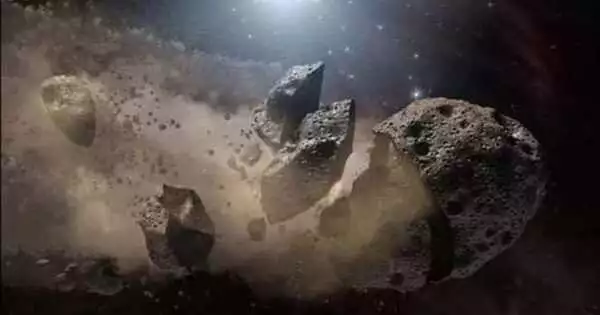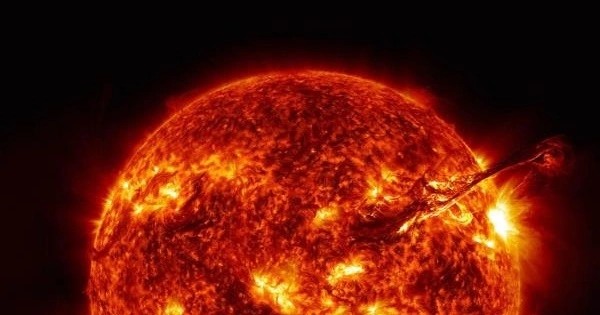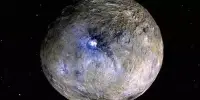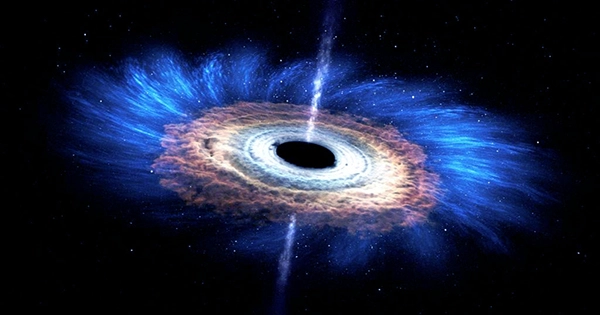NASA’s Double Asteroid Redirection Test (DART) is a mission designed to test whether it’s possible to deflect an asteroid by crashing a spacecraft into it. The successful outcome of the mission provides important insights into how we might protect Earth from potentially hazardous asteroids in the future.
Astronomers provide new insight into how deflection missions can protect Earth from future asteroids and comets. NASA’s Double Asteroid Redirection Test (DART) was the first attempt by Earth to launch a spacecraft designed to intentionally collide with and deflect an asteroid as a planetary defense technique.
On September 26, 2022, the DART spacecraft collided with Dimorphos, a small asteroid moon orbiting Didymos, a larger asteroid. Neither asteroid posed a threat to Earth, but they represented similar celestial bodies that could approach and endanger the planet in the future.
In four papers published in the journal Nature on March 1, 2023, the DART team — which includes University of Maryland astronomers — detailed DART’s successful impact, the possible physics behind the collision, observations of the resulting debris ejected from the asteroid and calculations of Dimorphos’ orbital changes. The findings support the feasibility of redirecting near-Earth objects such as asteroids as a form of planetary defense.
“We can’t stop hurricanes or earthquakes yet, but we’ve learned that with enough time, warning, and resources, we can prevent an asteroid impact,” said Derek Richardson, an astronomy professor at UMD and a DART investigation working group lead. “With enough time, a relatively minor change in an asteroid’s orbit would cause it to miss the Earth, preventing widespread destruction on our planet.”
When dealing with observations from a spacecraft, we need to understand where the spacecraft is in relation to the asteroid, the sun, and Earth, as well as which direction it is facing at any given time. With this information, we have a context in which to make hypotheses and evaluate our work.
Tony Farnham
DART mission more successful than expected
Richardson and his colleagues from the UMD Department of Astronomy, Professor Jessica Sunshine and Principal Research Scientist Tony Farnham, were instrumental in determining the effectiveness of the DART mission in deflecting an asteroid from an Earth-bound path.
Farnham was instrumental in computing the geometrical conditions and dimensions required to accurately interpret event observations. Farnham assisted in determining what the DART spacecraft was looking at as it approached Dimorphos by using data from spacecraft engineers and the Didymos Reconnaissance and Asteroid Camera for Optical Navigation (DRACO).
“When dealing with observations from a spacecraft, we need to understand where the spacecraft is in relation to the asteroid, the sun, and Earth, as well as which direction it is facing at any given time,” Farnham explained. “With this information, we have a context in which to make hypotheses and evaluate our work.”
Farnham’s work provided valuable information to the DART team about the general timeline of the impact, the location and nature of the impact site, and the size and shape of Dimorphos. The small asteroid was discovered to be an oblate spheroid, or a slightly squashed sphere-like body, rather than the more elongated shape predicted by theoretical predictions.
“Both Didymos and Dimorphos are more squishy in shape — looking more like peanut butter M&Ms and less like peanut M&Ms — than we expected,” Sunshine said. “This shape also challenges some of our preconceptions about how such asteroids form and complicates the physics behind DART because it prompts us to rethink our current models of binary asteroids.”

Aside from Dimorphos’ irregular shape, the scientists noticed that the surface of the asteroid was noticeably bouldery and blocky. This geomorphic quality most likely influenced crater formation, the amount and physical properties of ejecta (impact debris), and the momentum of a DART-like impact.
Sunshine, who previously worked as the deputy principal investigator for the UMD-led NASA Deep Impact mission, noticed that different textural qualities resulted in different impact outcomes, which was critical in determining how successfully the DART spacecraft redirected Dimorphos from its original orbit.
“The Deep Impact mission collided with a comet whose surface is made up of small, mostly uniform grains,” Sunshine explained. “Deep Impact resulted in a more uniform fan of debris than the filamentary structures seen after DART’s impact into bouldery terrain. As it turns out, the movement of DART-caused ejecta really had a profound effect on the success of DART’s mission.”
Extra push from impact debris shortened Dimorphos’ orbit
The DART spacecraft was not the only source of momentum in the collision with Dimorphos; violent debris spews caused an additional shove when the spacecraft collided with the small asteroid moon.
“There was so much debris ejected from the impact that Dimorphos was pushed approximately 3.5 times more effectively than if the DART spacecraft had been hit alone,” explained Richardson, who assisted in computing and verifying the momentum transferred between the DART spacecraft and Dimorphos.
This finding was confirmed, according to Farnham, who calculated the direction of the asteroid’s ejecta, when the team measured the asteroid’s orbit had changed more than the team’s more conservative expectations. The difference in orbital periods, or how long it takes a celestial object to complete one rotation around another, indicates that Dimorphos’ orbit around Didymos had changed.
“We expected the impact to shorten Dimorphos’ orbit by about 10 minutes before impact,” Farnham said. “However, after the impact, we discovered that the orbital period had been shortened even further, reducing an otherwise 12-hour orbit by slightly more than 30 minutes.” In other words, the ejected material acted as a jet, propelling the moon further away from its original orbit.”
Following up with Hera mission
The DART mission is a significant first step toward developing effective planetary defense strategies against near-Earth objects such as asteroids. The DART team hopes that the upcoming European Space Agency Hera mission, which will launch in October 2024, will reveal more information about the DART impact site. By 2026-27, the Hera spacecraft will return to the binary asteroid system containing Dimorphos and Didymos for the first time to assess the internal properties of both asteroids, providing a more detailed analysis of the DART impact’s effects on the system and the geophysics behind solar system formation.
“We still don’t know a lot about Dimorphos and Didymos because we have only seen the outsides,” Sunshine said. “What is their internal structure like? Are there differences in porosity between the two? Those are the types of questions we need to answer to really see how effective our deflections are and how celestial bodies like those asteroids form and evolve.”
While the Hera mission is still in the planning stages, research from DART and its predecessors such as Deep Impact continue to provide a wealth of information on how humans can develop new ways to defend Earth from approaching asteroids and comets. UMD astronomers are uniquely equipped to evaluate and advance planetary scale impact experimentation, thanks to a legacy of kinetic impact testing initiatives and planetary defense research led by the late Distinguished University Professor of Astronomy Mike A’Hearn. Richardson, Sunshine, Farnham, and their colleagues hope to continue pioneering new methods of asteroid threat mitigation in order to honor the work that led up to DART.
















